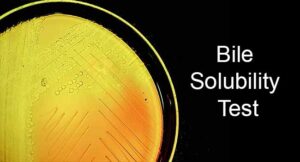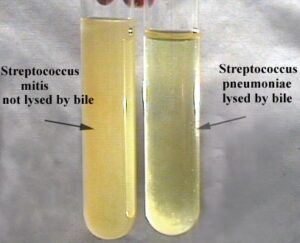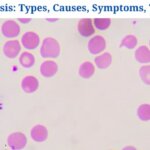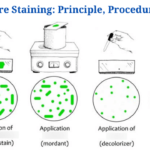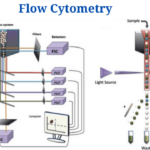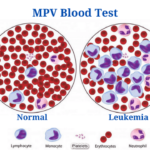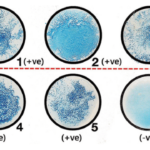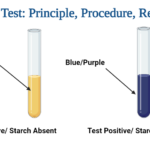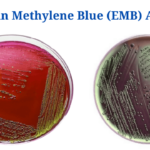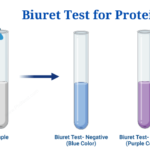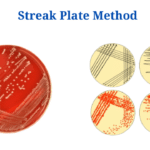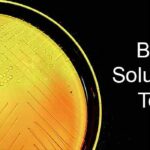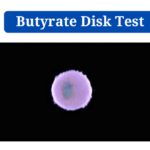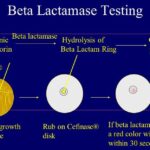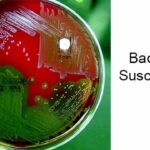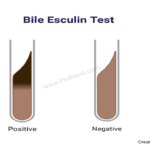What is Bile Solubility Test ?
The bile solubility test is a biochemical test used to distinguish Streptococcus pneumoniae from other alpha-hemolytic Streptococci and to confirm the diagnosis.
- The bile solubility test has been utilised as a critical test for S. pneumoniae differentiation because it enables for the difficult work of distinguishing between the two species, S. pneumoniae and Streptococcus pseudopneumoniae.
- Under some conditions, bacterial cell lysis in the presence of particular bile salts, such as sodium desoxycholate, is used to perform the test. Organisms that lyse are regarded as positive, whereas those that do not are seen as negative.
- The actual functioning mechanism of the test is unknown, but it is thought that the lysis is caused by the induction of autolytic enzymes.
- The bile solubility test is widely regarded as a reliable method of distinguishing S. pneumoniae from other mitis group streptococci, such as S. pseudopneumoniae.
- The method’s test findings, on the other hand, are difficult to interpret, especially when they are based on subjective human judgement.
Objectives of Bile Solubility Test
- To identify and differentiate pneumoniaefrom other alpha-hemolytic Streptococci.
- To determine whether or not an organism can lyse in the presence of bile salts.
How to increase Brain Power – Secrets of Brain Unlocked
Principle of Bile Solubility Test
- pneumoniae is identified and distinguished from alpha-hemolytic Streptococcus spp. using the bile solubility test.
- The test can be done with a cell suspension on a slide or in a tube, or by directly injecting the reagent into the colony.
- The bile solubility principle determines whether pneumococcal cells lyse when sodium desoxycholate (bile salts) is added to the colony under specified time and temperature circumstances, while other streptococci do not.
- When cultured on an artificial medium, the pneumococcus has an intracellular autolytic enzyme called amidase, which induces fast autolysis.
- Bile salts trigger cell membrane rearrangement by altering the surface tension of the medium.
- The actual working mechanism of the test is unknown; however, it is thought that the bile salts activate the autolytic enzyme, which aids in the lysis of pneumococcal cells.
- Bile salts trigger cell membrane rearrangement by altering the surface tension of the medium.
Microorganisms Tested
- Any alpha-hemolytic, catalase-negative, Gram-positive cocci in chains with S. pneumonia’s characteristic central depression (flattened centre) or mucoid colony shape.Any Gram-positive cocci from a positive blood culture in lancet-shaped pairs.
Media, Reagents, and Supplies Used
Reagents
- Bile salts
- A 10 percent bile salt solution can be bought or made at home.
- To make bile salt, dissolve 10 grammes sodium desoxycholate in 100 mL distilled water.
- To avoid contamination, the solution should be administered in small volumes. The solution normally has a shelf life of 270 days.
- 85% NaCl (sterilized)
- Broth culture medium (e.g. BHI)
Supplies
- Loops
- Test tubes or slide
- Pipettes
Procedure of Bile Solubility Test
Bile solubility test are often performed either via the tube method or direct plate method or direct slide blood culture method.
Test tube method
- About 0.5 ml of sterile saline or suitable broth is dispensed into alittle tube.
- A heavy suspension of the organism is ready within the saline (equivalent to no.1 McFarland standard). The suspension is then shaken by hand or on a vortex to make a consistent suspension.
- The suspension is split into two tubes, one labeled “TEST” and therefore the other labeled “CONTROL.”
- Put two to five drops of bile reagent into each of the tubes labelled “TEST” and “CONTROL.” Both tubes are carefully blended together.
- The tubes are then incubated for 3 hours at 35°C, checking hourly for clearing, or each tube are often examined by Gram’s method or methylthionine chloride wet mount for lysis of cells at an interval of quarter-hour.
Direct plate method
- A drop of bile reagent is dropped near a colony that has been suspected for 18 to 24 hours.
- By tilting the plate, the drop is then gently rolled across numerous representative colonies.
Note: Do not use the tip of the bile reagent dropper to touch the agar surface.
- The plate is incubated at 35°C for 15-30 minutes, or until the drop has evaporated, with the right side up. The plate also can be placed on a heat block as a substitute for the utilization of an incubator.
- The flattening of the colony is observed. Proper observation should be made to make sure that the colony doesn’t simply float away.
Direct slide blood culture test
- On a glass slide, mix one drop of blood culture broth with one drop of bile reagent and leave to dry.
- As an impact, one drop of broth blood culture is added to 1 drop of water and allowed to dry.
- Gram staining and cocci examination of the resultant suspension
Quality Control
As a sort of internal control for the bile solubility test, two different organisms are often taken as a positive and negative control.
[ninja_tables id=”3895″]Result Interpretation of Bile Solubility Test
Test tube method
- In comparison to the “CONTROL” tube, bile solubility is exhibited inside the tube method as a clearing or loss of turbidity after 3 hours. The lysis of cells when seen microscopically can also reveal it.
Direct slide blood culture method
- If all the cocci within the smear are entirely lysed, and therefore the control smear shows intact bacteria, the organism is bile soluble.
Direct plate method
- Bile solubility is demonstrated by the colony disintegrating or flattening after 30 minutes, leaving an alpha-hemolysis neighbourhood where the colonies were located.A negative result is demonstrated when there’s no change within the integrity of the colony within 30 min.
Reporting Results
- If an alpha-hemolytic colony from a catalase-negative, lancet-shaped, Gram-positive coccus shows bile solubility in either the spot or tube test, describe it as Streptococcus pneumoniae.
- If the test doesn’t demonstrate bile solubility, the organism is probably going a viridans group streptococcus, but a percentage of bile-resistant organisms should be S. pneumoniae; further testing is suggested from typical pneumococcal colonies.
Uses of Bile Solubility Test
- The bile solubility test is used to determine an organism’s ability to undergo lysis in the presence of bile salts.
- This test are often used for the differentiation and identification of S. pneumoniae from other alpha-hemolytic Streptococci.
- This test could be used to distinguish between bile-soluble and bile-insoluble organisms.
Bile Esculin Test: Objective, Principle, Procedure, Result, Uses, Limitations
Limitations of Bile Solubility Test
- Some S. pneumoniae organisms won’t lyse within the presence of bile, possibly thanks to the loss of virulence factor or capsule. If lysis isn’t present, the isolate should be S. pneumoniae. Therefore, colonies resembling S. pneumonia which aren’t bile soluble should be further identified using another method, like optochin susceptibility or DNA Probe and matrix-assisted laser desorption ionization time-of-flight spectrometry (MALDI-TOF).
- Bile solubility test should only be wont to differentiate S. pneumoniae from other alpha-hemolytic streptococci.
- Tube test-positive, spot test-negative strains should be verified using an optochin disc test, DNA probe, or MALDI-TOF for the highest specificity.Normal autolysis of S. pneumoniae could also be inhibited by a high concentration of bile salts. The reagent may become more concentrated as a result of evaporation, influencing the test.
- The bile solubility test isn’t reliable with old cultures that have autolyzed.
- When performing the bile solubility tube test using saline or unbuffered broth, it’s essential to regulate the pH to neutral before adding the reagent, so as to avoid false-negative reactions.
- When utilising the plate approach, take care not to dislodge the colony being examined, as this can result in false-positive findings. The test should be redone using the tube or slide approach if the direct plate is difficult to understand.
- The reagent might thicken if it is stored at low temperatures. Before used, the reagent vial should be warmed in a 37 incubator to liquefy the reagent.
Bile Solubility Test Citations
- Slotved, H. C., Facklam, R. R., & Fuursted, K. (2017). Assessment of a novel bile solubility test and MALDI-TOF for the differentiation of Streptococcus pneumoniae from other mitis group streptococci. Scientific reports, 7(1), 7167. https://doi.org/10.1038/s41598-017-07772-x
- Tille, P.M., et al. Bailey and Scott’s Diagnostic Microbiology, Mosby Company, St. Louis, MO.
- https://microbiologynotes.com/bile-solubility-test-principle-procedure-result-interpretation-examples-and-limitation/
- http://www.apsi.it/public/ufiles/smi/tp5_3_en_141111.pdf
- https://catalog.hardydiagnostics.com/cp_prod/content/hugo/BileSpotRgnt.htm
- http://www.nature.com/articles/s41598-017-07772-x
- https://www.sciencedirect.com/topics/immunology-and-microbiology/optochin
- https://assets.thermofisher.com/TFS-Assets/LSG/manuals/IFU21206.pdf
- http://www.keydiagnostics.com.au/clinical-testing-2/products-by-organism/bile-spot-reagent-detail
- https://www.sciencedirect.com/topics/neuroscience/lysis
- https://www.researchgate.net/publication/274261127_Current_methods_for_capsular_typing_of_Streptococcus_pneumoniae
Related Posts
- Anisocytosis: Definition, Types, Causes, Symptoms, Treatment
- Endospore Staining: Principle, Procedure, Reagents, Results
- Flow Cytometry: Overview, Principle, Steps, Types, Uses
- Northern Blot: Overview, Principle, Procedure and Results
- MPV Blood Test: Calculation, High and Low MPV Value, Results
- Latex Agglutination Test: Objectives, Principle, Procedure, Results
- Iodine Test: Definition, Objective, Principle, Procedure, Results
- Eosin Methylene Blue (EMB) Agar
- Biuret Test for Protein: Purpose, Objectives, Principle, Procedure, Reagents
- Streak Plate Method: Meaning, Principle, Methods, Importance, Limitations
- Bile Solubility Test: Objective, Principle, Procedure, Results, Uses
- Butyrate Disk Test: Objective, Principle, Procedure, Results, Uses, Limitations
- Beta Lactamase Test: Objective, Principle, Procedure, Results, Limitations
- Bacitracin Susceptibility Test: Objective, Principle, Procedure, Results, Uses, Limitations
- Bile Esculin Test: Objective, Principle, Procedure, Result, Uses, Limitations

